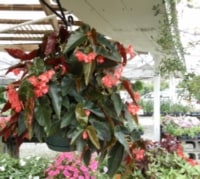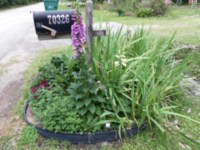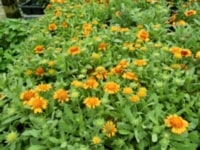
Warm Season Plants for Summer Color
Start adding warm season bedding plants to provide color in your landscape. While petunias and calibrachoas (supertunias) are still blooming, they will start fading as the weather begins to heat up. Don’t be tempted to continue to buy too many of the cool season plants. You can however, use them in hanging baskets to add some color for a longer period of time and putting them in part sun to extend flowering. Heat-tolerant plants come in a wide variety of colors and growth habits. Here are some of the best:
For low-growing summer bedding plants (less than 2 feet), choose Mexican heather, ornamental peppers, ornamental sweet potatoes, dwarf angelonia, coleus, impatiens, periwinkle, dwarf cosmos, begonia, dwarf pentas, dwarf globe amaranth, ageratum, salvia ‘Victoria,’ marigolds, portulaca, blue daze, perennial verbena, purslane, dusty miller, rudbeckia, purple cone flower, abelmoschus, narrow-leaf zinnia, wishbone flower, Dahlberg daisy, caladium, balsam, gerbera daisy, gaillardia, celosia, dwarf lantana, scaevola or dwarf melampodium.
For taller-growing (more than 2 feet), choose butterfly weed, angelonia, shrimp plant, cleome, pentas, melampodium, four o’clock, perilla, cosmos, hardy hibiscus (mallow), sunflower, salvias, lantana, cigar flower or Mexican sunflower (tithonia).
Rose Mallow Hibiscus

Rose Mallow hibiscus, Hibiscus moscheutus can be planted through July. It is easily planted from seeds in pots in Spring. They bloom the first year planted. Planted in full sun, they can grow well in poorly drained soil but plant in average soil using organic matter and a general purpose fertilizer before planting. They group 2-4 feet X 2-3 feet. Plants should be mulched and produce large flowers in early summer in red, white and pink as well as various combinations of these colors. Plants begins to turn yellow and brown in early fall and should be cut several inches from the ground. On the Northshore, I let them die back with the cold. I leave some of the dried stalks to mark the plant location until they return next year. ‘Disco Belle’ is a popular variety.
Foxgloves are in Bloom

The Camelot foxglove, Digitalis purpurea, you planted last fall and winter is currently in full bloom. They are seed-propagated. Tall flower stalks in colors of white, cream, lavender and rose. The foxglove flowers gives gardens an old fashioned English garden feel. For best landscape results, plant transplants in the garden in October or November for spring flowers. You can also wait to plant until late January through mid-March, but plants put in at this time of the year don’t do as well as fall planting. Prune old flower plumes as they fade. Foxgloves perform well in full sun to partial sun/partial shade. Watch out for aphids which can be a problem but are easily removed with a hard spray of water from a hose.

Garden Maintenance
Control thrips, aphids, cucumber beetles and spider mites on roses by using a recommended insecticide or miticide. Also, continue blackspot control by using a recommended fungicide at seven- to 10-day intervals. When irrigating, water the soil area thoroughly. Irrigate less often, but irrigate well each time. Light, overhead sprinkling is not the best way to water. Continue to plant warm-season bedding plants.
During early summer, gardenias may have aphids, whiteflies and the associated black sooty mold. For optimum plant performance, control the insects with Orthene or a summer horticultural oil spray.
Camellias and azaleas need care to set a good crop of flower buds for next year. Healthy, vigorous plants will set buds, but weak plants may not. If plants lack vigor, fertilize, provide moisture during stressful periods and control pests. Remember that these acid-loving plants may have problems if soils are too alkaline. Submit a soil sample to your parish LSU AgCenter extension agent if you are unsure of your soil situation.
Louisiana irises are semi-dormant during late summer. Prune off seedpods and yellow or brown foliage to help keep the plants more attractive.
Cut faded flowers from flowering annuals and perennials to encourage new growth and flowers. Old blooms and seed heads left on the plants can retard continued flower production.
Slimy Pests in the Garden
Snails and slugs can be a problem in summer gardens especially after excessive rain . They damage plants by chewing holes in the leaves and flowers of ornamen-tals, particularly of low-growing plants with tender leaves, like impatiens and hostas. Using commercial baits according to the directions on their labels is helpful in reducing the populations of snails and slugs. But you have to be persistent, since you are not likely to get these pests under control easily.
Baits containing metaldehyde have been a standard and effective treatment for years. Metaldehyde, however, is toxic to dogs and cats, so care must be taken when using it.
A newer, safer and much less toxic active ingredient is iron phosphate, which is sold under various brand names. No special precautions need to be taken when using this type of bait.
Trapping is a good way to monitor population levels. A trap is easily constructed using a small, disposable bowl and some beer. If you suspect snails and slugs are causing the damage but you do not catch any in the beer traps, the damage is more likely being caused by caterpillars or beetles. These pests also chew holes in leaves similar to snails and slugs.
Green Lawns

From now through September sod for lawns can be done. For established lawns, homeowners still have time to fertilize and get your lawn in good shape prior to fall. Keep up a good fertility program through early to mid-August only. Apply all granular materials on a dry lawn and water soon after application. St. Augustine grass and zoysia respond well to fertilizer and should be fertilized two to three times during the growing season. Bermuda grass is an even bigger fertilizer user and could be fertilized even more often, especially if you like to mow grass. Carpet grass and centipede are not big fertilizer users. Make sure lawns are getting adequate amounts of moisture during the summer months, but don’t overwater. Water deeply only once or twice per week – or as needed, based on the amount of rainfall.
Veggies for early Summer
May/June: Transplant heat-set tomatoes. They will produce fruit from August through October. You also can plant collards, cucumbers, melons, cantaloupes, okra, southern peas, pumpkins, summer squash, amaranth, cucuzzi, cushaw, Malabar spinach, soybeans, peanuts, lima beans, luffa gourd, mirliton and yard-long beans. Transplant eggplants, peppers (bell and hot) and sweet potato slips. Start seed of fall tomatoes and bell peppers. Good pest control practices are necessary because of the high pressure of insects and diseases right now.
Irish potatoes
Begin digging 90-110 days after planting. Plant tops start turning yellow as tubers reach maturity. Allowing the potatoes to remain in the ground a few days after tops die or after tops are cut will help set or toughen the skin and reduce skinning, bruising and storage rot.
Spraying potatoes with a general-purpose fungicide (Daconil or Maneb) at the end of April or early May will protect the foliage from early blight and improve yields.
To keep potatoes for several weeks, allow cuts and skinned places to heal over at high temperatures. Then store in a cool, dark place with high humidity. Don’t store where they will receive light because they will turn green and develop an undesirable taste.
Sweet Potatoes
Gardeners can bed seed potatoes from April into May. Transplants should be ready to cut in Four to five weeks. Sweet potatoes slips (transplants) can be set out in late April if soil is warm enough (greater than 70 degrees Fahrenheit).Cut plants from plant bed about 1inch above soil line and transplant. Purchase weevil-free plants. Cutting rather than pulling, helps reduce sweet potato weevils and many disease problems. Cuttings develop feeder roots within a day or two if the soil is warm and moist. Holding the cut slips in the shade for two to three days before transplanting will help increase survival. Use a low-nitrogen fertilizer such as 6-24-24 or 8-24-24 at 2-3 pounds per 100foot row. Beauregard is the most popular variety.
Lima beans (butter beans)
Lima beans require warmer soil (70 degrees Fahrenheit, at least) than snap beans to germinate, so wait until soil warms (usually in early to mid-April) before planting. Bush varieties to plant are Henderson’s Bush, Fordhook 242, Thorogreen, Bridgeton, Nemagreen, Dixie Butterpea or Baby Fordhook.
Plant lima beans every two weeks through mid-May to extend the harvest. One-half pound of seed will plant a 100-foot row when three or four seeds are planted every 12 inches within the row.
Recommended pole lima beans are King of the Garden, Carolina Sieva, Willow Leaf, Florida Butter, Christmas and Florida Speckled. Plant seeds 6-12 inches apart. One-quarter pound of seed will plant a 100-foot row.
submitted by Karen Blackburn
